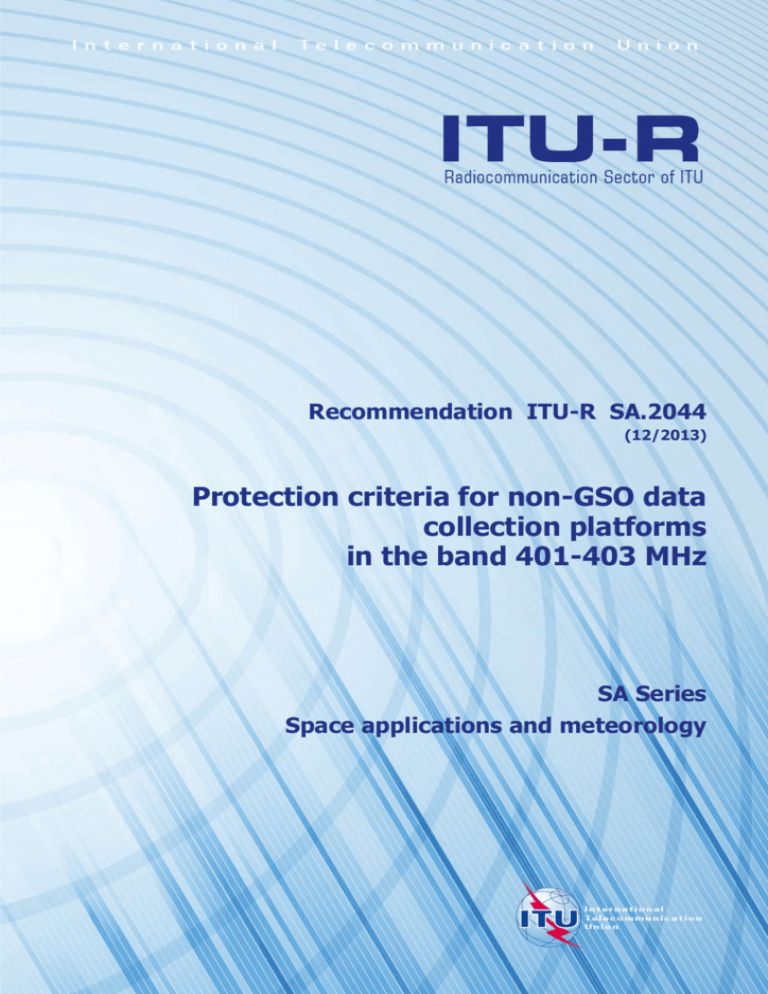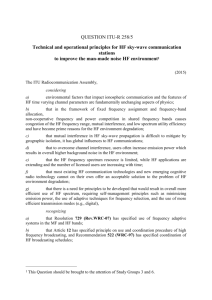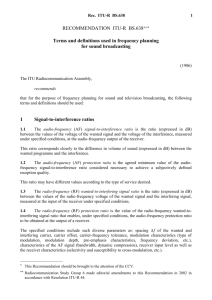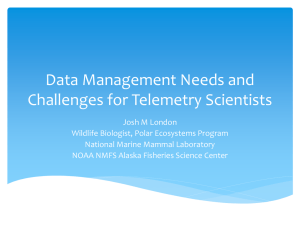
Recommendation ITU-R SA.2044
(12/2013)
Protection criteria for non-GSO data
collection platforms
in the band 401-403 MHz
SA Series
Space applications and meteorology
ii
Rec. ITU-R SA.2044
Foreword
The role of the Radiocommunication Sector is to ensure the rational, equitable, efficient and economical use of the
radio-frequency spectrum by all radiocommunication services, including satellite services, and carry out studies without
limit of frequency range on the basis of which Recommendations are adopted.
The regulatory and policy functions of the Radiocommunication Sector are performed by World and Regional
Radiocommunication Conferences and Radiocommunication Assemblies supported by Study Groups.
Policy on Intellectual Property Right (IPR)
ITU-R policy on IPR is described in the Common Patent Policy for ITU-T/ITU-R/ISO/IEC referenced in Annex 1 of
Resolution ITU-R 1. Forms to be used for the submission of patent statements and licensing declarations by patent
holders are available from http://www.itu.int/ITU-R/go/patents/en where the Guidelines for Implementation of the
Common Patent Policy for ITU-T/ITU-R/ISO/IEC and the ITU-R patent information database can also be found.
Series of ITU-R Recommendations
(Also available online at http://www.itu.int/publ/R-REC/en)
Series
BO
BR
BS
BT
F
M
P
RA
RS
S
SA
SF
SM
SNG
TF
V
Title
Satellite delivery
Recording for production, archival and play-out; film for television
Broadcasting service (sound)
Broadcasting service (television)
Fixed service
Mobile, radiodetermination, amateur and related satellite services
Radiowave propagation
Radio astronomy
Remote sensing systems
Fixed-satellite service
Space applications and meteorology
Frequency sharing and coordination between fixed-satellite and fixed service systems
Spectrum management
Satellite news gathering
Time signals and frequency standards emissions
Vocabulary and related subjects
Note: This ITU-R Recommendation was approved in English under the procedure detailed in Resolution ITU-R 1.
Electronic Publication
Geneva, 2014
ITU 2014
All rights reserved. No part of this publication may be reproduced, by any means whatsoever, without written permission of ITU.
Rec. ITU-R SA.2044
1
RECOMMENDATION ITU-R SA.2044
Protection criteria for non-GSO data collection platforms
in the band 401-403 MHz
(Questions ITU-R 139/7 and ITU-R 141/7)
(2013)
Scope
This Recommendation provides information on the current and future usage of the non-GSO data collection
systems (DCS) in the 401-403 MHz, and the portioning of the band to allow all DCS systems equal access to
the spectrum.
The ITU Radiocommunication Assembly,
considering
a)
that system designers require performance objectives in the presence of interference for
their systems;
b)
that performance objectives for representative systems operating in the EESS and MetSat
services are intended to provide guidelines for the development of actual systems;
c)
that performance objectives for EESS and MetSat services are a prerequisite for conducting
interference assessments;
d)
that protection criteria are required to meet the desirable performance objectives in the
presence of interference,
recommends
1
that the analysis to determine the effect on non-GSO DCS systems in the 401-403 MHz
should be based on the following protection criteria:
–
–197.9 dB(W/(m2 · Hz)) maximum aggregate acceptable spectral power flux-density (spfd)
at the antenna of a non-GSO DCS instrument for broadband noise interference
(see Annex 1);
–
–165.4 dB(W/m2) maximum power flux-density (pfd) within a resolution bandwidth of
19 Hz at the antenna of a non-GSO DCS instrument for each narrow-band spectral line
interference (see Annex 2);
2
that protection criteria defined in recommends 1 should not be exceeded for more than
a percentage of 1% of time in the field of view of the satellite.
2
Rec. ITU-R SA.2044
Annex 1
Protection criteria for non-GSO DCS instruments in the band 401-401.69 MHz
against broadband noise interference emissions
1
Introduction
This Annex provides information relating to an existing typical non-GSO DCS system in operation
so called ARGOS and therefore to its protection requirements from broadband noise interference
emissions.
2
Spectral power flux-density threshold level of interference
The addition of broadband noise to the ARGOS instrument will have the effect of increasing the
system bit-error ratio (BER), and therefore adversely affect its performance requirement.
This analysis identifies the maximum acceptable pfd associated with broadband noise in the
ARGOS uplink channel.
Figure 1 shows the main hardware elements on board the NOAA satellites. This general principle
is applicable to METOP and NOAA satellites.
FIGURE 1
On-board hardware equipment
A-DCS/SARP receive antenna
(UDA)
A-DCS
Attenuation: 1.6 dB
pfd
A
B
SA.2044-01
The UDA antenna gain pattern specification is expressed according to the nadir angle in Table 1:
TABLE 1
SARP/ARGOS receive antenna (UDA) gain pattern
Nadir satellite
angle
62
59
54
47
39
31
22
13
5
0
Gain in RHCP
3.85
3.54
2.62
1.24
–0.17
–1.33
–2.24
–3.08
–3.80
–3.96
Gain in LHCP
–5.69
–6.23
–7.52
–9.39
–11.39
–13.12
–14.52
–15.77
–17.17
–18.00
Axial ratio
6.02
5.85
5.59
5.26
4.90
4.57
4.31
4.11
3.78
3.49
The specified figures in Table 1 are of the receive antenna pattern shared between the SARP and
ARGOS instruments, as they should be for the NOAA and METOP satellites.
The ARGOS typical figures are: noise figure = 3 dB (ARGOS input parameter), worst-case
background noise temperature = 1 200 K (measured value taking into account the industrial noise in
Rec. ITU-R SA.2044
3
Europe), attenuation between the antenna and the ARGOS receiver = 1.6 dB. Thus, the system
noise temperature at the input of the ARGOS receiver (point B on Fig. 1) equals 1 214 K and
therefore, the noise spectral density equals N0 = –197.8 dB(W/Hz).
The worst-case specification states that the ARGOS is designed to operate correctly when the
received signal has a power C = −160 dBW (minimum level of the received signal) at the input of
the receiver, which provides an effective Eb/N0 = 8.3 dB in the bit detector of the ARGOS if we take
into account the beacon waveform and the various losses.
Therefore, in order to achieve a BER of 2 × 10–4 that corresponds to a minimum Eb/N0 of 8 dB,
the maximum acceptable degradation is 0.3 dB.
Hereunder, the additive noise corresponding to the 0.3 dB degradation for the C/N0 is calculated.
Let I0 represent the additive noise power density. Therefore, the initial N0 noise becomes N0 + I0.
The signal-to-noise ratio C/N0 becomes C/(N0 + I0).
The degradation is 0.3 dB = 10 log ((C/N0)/(C/(N0 + I0))), thus I0 /N0 = −11.5 dB and
I0 = −209.3 dB(W/Hz) which corresponds to a temperature of 86 K, and therefore an increase of 7%
of the system noise temperature at the input of the receiver.
Therefore, the maximum admissible level of noise density is I0 = −209.3 dB(W/Hz) (calculated for
point B in Fig. 1).
As shown in Fig. 1, the noise density, I0, takes into account the attenuation and the antenna gain.
As the spfd is required, it is necessary to transform this figure in dB(W/(m2 · Hz)). The equivalent
2
surface area of an antenna having a gain G is S G 4 . Therefore, the corresponding spfd equals
−209.3 + 1.6 (losses) – 10 log10S = −197.9 dB(W/(m2 · Hz)), taking into account the highest
satellite nadir angle.
Annex 2
Protection criteria for non-GSO DCS instruments in the band 401-401.69 MHz
against narrow-band spectral line interference emissions
1
Introduction
This Annex provides information relating to an existing typical non-GSO DCS system in operation
so called ARGOS and therefore to its protection requirements against narrow-band spectral line
interference emissions.
2
Background
Annex 1 contains the protection criteria for ARGOS in the band 401-401.69 MHz to be used
as a basis for analysis of interference from broadband interference emissions. This Annex provides
protection requirements for the ARGOS instrument in respect of interference from narrow-band
spectral line interference emissions.
4
3
Rec. ITU-R SA.2044
Protection requirement from narrow-band spectral line emissions
Figure 1 shows the main ARGOS hardware elements.
To better understand the rationale of this specification, it is necessary to briefly recall the behaviour
of the instrument.
ARGOS beacon transmissions begin with 160 ms of unmodulated carrier to allow a phase-locked
loop to lock more easily on the carrier. Figure 2 represents the ARGOS message format.
FIGURE 2
DCS message format
160 ms carrier
Synchronization bits
DCS beacon
message content bits
SA.2044-02
A spectrum analyser in the instrument continuously monitors the full coverage bandwidth in search
of the pure carrier portion of the DCS messages. When the spectrum analyser detects such a line,
it considers that it is the beginning of a DCS message. The theory is based on the detection of a pure
carrier wave (sine wave) in a white, additive and Gaussian noise environment. The power spectral
density of the received signal (pure carrier + noise) is computed using fast Fourier transform
techniques, and each signal above the system threshold is processed as if it were a DCS beacon
(see Fig. 3).
FIGURE 3
Detection of a sine wave in white Gaussian noise
Power spectral density
Detected peaks
Threshold
f
SA.2044-03
The ARGOS receiver processors are therefore designed to detect discrete spectral components
(unmodulated beacon carrier) and the corresponding resolution bandwidth is 19 Hz. Signals above
the threshold level are assigned to an on-board data recovery unit (DRU) for further processing and
transmission to the Earth on the mission telemetry channel.
In order to satisfy ARGOS detection probability performances for a wide range of user applications
(wild animal tracking, fishery, oceanography, etc.), the ARGOS instrument has been designed to
detect and process extremely weak signals. Its performance is such that any signal, Cmin,
which exceeds the local noise density level by 21 dB(Hz) (Cmin / N0 21 dB(Hz)) would be assigned
to a DRU for additional processing. Consequently, narrow-band interfering signals meeting this
criteria would cause a DRU to be assigned to it. The consequence would be that the performance of
the ARGOS instrument, in terms of capacity (e.g. the number of simultaneous DCS messages that
are able to be processed), would be seriously degraded.
Rec. ITU-R SA.2044
5
The ARGOS typical figures are: noise factor = 3 dB (ARGOS typical figure), worst-case
background noise temperature = 1 200 K (ARGOS input parameter), attenuation between the
antenna and the receiver = 1.6 dB. Thus, the system noise temperature at the input of the receiver
(point B on Fig. 1) equals 1 214 K and therefore, the noise spectral density equals
N0 = −197.8 dB(W/Hz).
As Cmin / N0 = 21 dB(Hz), Cmin = −176.8 dBW. Therefore, any narrow-band spurious emission
greater than −176.8 dBW at the input of the ARGOS (point B of Fig. 1), would result in
a degradation of the system capacity.
It is then necessary to compute this maximum admissible level of spectral line at the input of the
ARGOS antenna.
The ARGOS receive antenna gain pattern specification is expressed according to the nadir angle in
Table 2.
TABLE 2
Receive antenna (UDA) gain pattern
Nadir satellite
angle
62
59
54
47
39
31
22
13
5
0
Gain in RHCP
3.85
3.54
2.62
1.24
–0.17
–1.33
–2.24
–3.08
–3.80
–3.96
Gain in LHCP
–5.69
–6.23
–7.52
–9.39
–11.39
–13.12
–14.52
–15.77
–17.17
–18.00
Axial ratio
6.02
5.85
5.59
5.26
4.90
4.57
4.31
4.11
3.78
3.49
Therefore, the maximum admissible power at point A of Fig. 1 equals –176.8 + 1.6 (losses) =
−175.2 dBW, taking into account the highest satellite nadir angle. As the pfd is required,
it is necessary to transform this figure in dB(W/m2). The equivalent surface area of an antenna
having a gain G is
2
S G 4
corresponding to the highest satellite nadir angle.
Therefore, the corresponding pfd equals –175.2 – 10 log10S = −165.4 dB(W/m2).
4
Conclusion
Following the above computations, the conclusions and recommendations regarding the impact of
the aggregation of spectral narrow-band interference emissions, should not exceed
−165.4 dB(W/m2) at the input of the ARGOS antenna for the frequency band 401-401.69 MHz,
within a resolution bandwidth of 19 Hz.
______________









